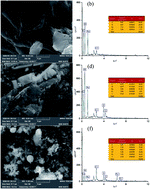A Fe-OSA/Nafion composite film-decorated glassy carbon electrode as a sensor for detection of Pb(ii), Cd(ii) and Cu(ii)†
Abstract
A glassy carbon electrode decorated with Fe-OSA was successfully fabricated and its application in electrochemical detection of heavy ions was investigated. Fe-OSA was characterized by scanning electron microscopy (SEM), energy dispersive spectroscopy (EDS), X-ray diffraction (XRD), and Fourier transform infrared (FTIR) spectroscopy. The properties of glassy carbon electrode (GCE) before and after modification were analyzed by cyclic voltammetry (CV), and the swelling, reproducibility, and thermal stability of Fe-OSA were studied. In the case of Pb(II), electrochemical detection was conducted by varying different parameters such as electrolyte, pH and deposition time. The electrochemical behavior of three heavy metal ions (Cd(II), Cu(II), and Pb(II)) on Fe-OSA-modified GCE was investigated under optimum conditions by differential pulse voltammetry (DPV). Using DPV, it was found that Fe-OSA-modified GCE could be used to effectively detect Cd(II), Cu(II) and Pb(II) individually. According to the obtained parameters (correlation coefficients and limit of detection) from the linear relationship between current and concentration, it was revealed that metal ions in low concentrations could also be detected simultaneously with high sensitivity.



 Please wait while we load your content...
Please wait while we load your content...